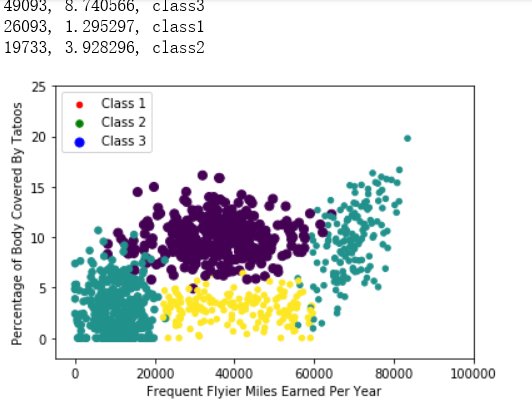吴裕雄 python 机器学习-KNN(2)
import matplotlib
import numpy as np
import matplotlib.pyplot as plt
from matplotlib.patches import Rectangle n = 1000 #number of points to create
xcord = np.zeros((n))
ycord = np.zeros((n))
markers =[]
colors =[]
fw = open('D:\\LearningResource\\machinelearninginaction\\Ch02\\EXTRAS\\testSet.txt','w') for i in range(n):
[r0,r1] = np.random.standard_normal(2)
myClass = np.random.uniform(0,1)
if (myClass <= 0.16):
fFlyer = np.random.uniform(22000, 60000)
tats = 3 + 1.6*r1
markers.append(20)
colors.append(2.1)
classLabel = 1 #'didntLike'
print(("%d, %f, class1") % (fFlyer, tats))
elif ((myClass > 0.16) and (myClass <= 0.33)):
fFlyer = 6000*r0 + 70000
tats = 10 + 3*r1 + 2*r0
markers.append(20)
colors.append(1.1)
classLabel = 1 #'didntLike'
print(("%d, %f, class1") % (fFlyer, tats))
elif ((myClass > 0.33) and (myClass <= 0.66)):
fFlyer = 5000*r0 + 10000
tats = 3 + 2.8*r1
markers.append(30)
colors.append(1.1)
classLabel = 2 #'smallDoses'
print(("%d, %f, class2") % (fFlyer, tats))
else:
fFlyer = 10000*r0 + 35000
tats = 10 + 2.0*r1
markers.append(50)
colors.append(0.1)
classLabel = 3 #'largeDoses'
print(("%d, %f, class3") % (fFlyer, tats))
if (tats < 0):
tats =0
if (fFlyer < 0):
fFlyer =0
xcord[i] = fFlyer
ycord[i]=tats
fw.write("%d\t%f\t%f\t%d\n" % (fFlyer, tats, np.random.uniform(0.0, 1.7), classLabel)) fw.close() fig = plt.figure()
ax = fig.add_subplot(111)
ax.scatter(xcord,ycord, c=colors, s=markers)
type1 = ax.scatter([-10], [-10], s=20, c='red')
type2 = ax.scatter([-10], [-15], s=30, c='green')
type3 = ax.scatter([-10], [-20], s=50, c='blue')
ax.legend([type1, type2, type3], ["Class 1", "Class 2", "Class 3"], loc=2)
ax.axis([-5000,100000,-2,25])
plt.xlabel('Frequent Flyier Miles Earned Per Year')
plt.ylabel('Percentage of Body Covered By Tatoos')
plt.show()

...................................................

import numpy as np
import matplotlib
import matplotlib.pyplot as plt
from matplotlib.patches import Rectangle n = 1000 #number of points to create
xcord1 = []; ycord1 = []
xcord2 = []; ycord2 = []
xcord3 = []; ycord3 = []
markers =[]
colors =[]
fw = open('D:\\LearningResource\\machinelearninginaction\\Ch02\\EXTRAS\\testSet.txt','w') for i in range(n):
[r0,r1] = np.random.standard_normal(2)
myClass = np.random.uniform(0,1)
if (myClass <= 0.16):
fFlyer = np.random.uniform(22000, 60000)
tats = 3 + 1.6*r1
markers.append(20)
colors.append(2.1)
classLabel = 1 #'didntLike'
xcord1.append(fFlyer)
ycord1.append(tats)
elif ((myClass > 0.16) and (myClass <= 0.33)):
fFlyer = 6000*r0 + 70000
tats = 10 + 3*r1 + 2*r0
markers.append(20)
colors.append(1.1)
classLabel = 1 #'didntLike'
if (tats < 0):
tats =0
if (fFlyer < 0):
fFlyer =0
xcord1.append(fFlyer)
ycord1.append(tats)
elif ((myClass > 0.33) and (myClass <= 0.66)):
fFlyer = 5000*r0 + 10000
tats = 3 + 2.8*r1
markers.append(30)
colors.append(1.1)
classLabel = 2 #'smallDoses'
if (tats < 0):
tats =0
if (fFlyer < 0):
fFlyer =0
xcord2.append(fFlyer)
ycord2.append(tats)
else:
fFlyer = 10000*r0 + 35000
tats = 10 + 2.0*r1
markers.append(50)
colors.append(0.1)
classLabel = 3 #'largeDoses'
if (tats < 0): tats =0
if (fFlyer < 0): fFlyer =0
xcord3.append(fFlyer)
ycord3.append(tats)
fw.write("%d\t%f\t%f\t%d\n" % (fFlyer, tats, np.random.uniform(0.0, 1.7), classLabel)) fw.close()
fig = plt.figure()
ax = fig.add_subplot(111)
# ax.scatter(xcord,ycord, c=colors, s=markers)
type1 = ax.scatter(xcord1, ycord1, s=20, c='red')
type2 = ax.scatter(xcord2, ycord2, s=30, c='green')
type3 = ax.scatter(xcord3, ycord3, s=50, c='blue')
ax.legend([type1, type2, type3], ["Did Not Like", "Liked in Small Doses", "Liked in Large Doses"], loc=2)
ax.axis([-5000,100000,-2,25])
plt.xlabel('Frequent Flyier Miles Earned Per Year')
plt.ylabel('Percentage of Time Spent Playing Video Games')
plt.show()

import numpy as np
import matplotlib
import matplotlib.pyplot as plt def file2matrix(filename):
fr = open(filename)
returnMat = []
classLabelVector = [] #prepare labels return
for line in fr.readlines():
line = line.strip()
listFromLine = line.split('\t')
returnMat.append([float(listFromLine[0]),float(listFromLine[1]),float(listFromLine[2])])
classLabelVector.append(int(listFromLine[-1]))
return np.array(returnMat),np.array(classLabelVector) fig = plt.figure()
ax = fig.add_subplot(111)
datingDataMat,datingLabels = file2matrix('D:\\LearningResource\\machinelearninginaction\\Ch02\\datingTestSet2.txt')
#ax.scatter(datingDataMat[:,1], datingDataMat[:,2])
ax.scatter(datingDataMat[:,1], datingDataMat[:,2], 15.0*np.array(datingLabels), 15.0*np.array(datingLabels))
ax.axis([-2,25,-0.2,2.0])
plt.xlabel('Percentage of Time Spent Playing Video Games')
plt.ylabel('Liters of Ice Cream Consumed Per Week')
plt.show()

吴裕雄 python 机器学习-KNN(2)的更多相关文章
- 吴裕雄 python 机器学习——KNN回归KNeighborsRegressor模型
import numpy as np import matplotlib.pyplot as plt from sklearn import neighbors, datasets from skle ...
- 吴裕雄 python 机器学习——KNN分类KNeighborsClassifier模型
import numpy as np import matplotlib.pyplot as plt from sklearn import neighbors, datasets from skle ...
- 吴裕雄 python 机器学习-KNN算法(1)
import numpy as np import operator as op from os import listdir def classify0(inX, dataSet, labels, ...
- 吴裕雄 python 机器学习——半监督学习LabelSpreading模型
import numpy as np import matplotlib.pyplot as plt from sklearn import metrics from sklearn import d ...
- 吴裕雄 python 机器学习——半监督学习标准迭代式标记传播算法LabelPropagation模型
import numpy as np import matplotlib.pyplot as plt from sklearn import metrics from sklearn import d ...
- 吴裕雄 python 机器学习——分类决策树模型
import numpy as np import matplotlib.pyplot as plt from sklearn import datasets from sklearn.model_s ...
- 吴裕雄 python 机器学习——回归决策树模型
import numpy as np import matplotlib.pyplot as plt from sklearn import datasets from sklearn.model_s ...
- 吴裕雄 python 机器学习——线性判断分析LinearDiscriminantAnalysis
import numpy as np import matplotlib.pyplot as plt from matplotlib import cm from mpl_toolkits.mplot ...
- 吴裕雄 python 机器学习——逻辑回归
import numpy as np import matplotlib.pyplot as plt from matplotlib import cm from mpl_toolkits.mplot ...
随机推荐
- Java - 22 Java 多态
Java 多态 多态是同一个行为具有多个不同表现形式或形态的能力. 多态性是对象多种表现形式的体现. 比如我们说"宠物"这个对象,它就有很多不同的表达或实现,比如有小猫.小狗.蜥蜴 ...
- CentOS7.4安装部署openstack [Liberty版] (一)
一.OpenStack简介 OpenStack是一个由NASA(美国国家航空航天局)和Rackspace合作研发并发起的,以Apache许可证授权的自由软件和开放源代码项目. OpenStack是一个 ...
- Tomcat启动报错:Possible root causes include a too low setting for -Xss and illegal cyclic inheritance dependencies
错误代码如下: Caused by: java.lang.IllegalStateException: Unable to complete the scan for annotations for ...
- selenium元素定位Xpath,Contains,CssSelector
最近有人问到定位问题,基本上我用以下三个方法可解决,但不同的项目使用方法不一样.以下为自己所用的简单记录说明 1.Xpath 经常使用且最能解决问题的定位 driver.findElement(By. ...
- 五大排序算法(Python)
冒泡排序 冒泡排序通常是在CS入门课程中教的,因为它清楚地演示了排序是如何工作的,同时又简单易懂.冒泡排序步骤遍历列表并比较相邻的元素对.如果元素顺序错误,则交换它们.重复遍历列表未排序部分的元素,直 ...
- HDU1847 Good Luck in CET-4 Everybody 博弈 SG函数
题意:给定n张牌,两个人轮流摸牌,每次摸牌张数为2的幂次,问先手胜还是后手胜 n≤1000 题目链接:http://acm.hdu.edu.cn/showproblem.php?pid=1847 # ...
- 关于QT_Creator不能在线调试问题
电脑:W7+64位,QT:5_7_0(vs2015版本) 用QTcreator进行在线调试时出现找不到“engine...”,原因是没有在线调试软件 CDB下载地址:http://msdn.micro ...
- django, tornado
django 由多线程写的 tornaod 由epoll机制
- Exchange Tech Issues 参考网站
Exchange Tech Issues: https://www.experts-exchange.com/ DAG部署: http://blog.51cto.com/4096415/958671
- 《算法》第三章部分程序 part 3
▶ 书中第三章部分程序,加上自己补充的代码,红黑树 ● 红黑树,大部分方法与注释与二叉树相同 package package01; import java.util.NoSuchElementExce ...
